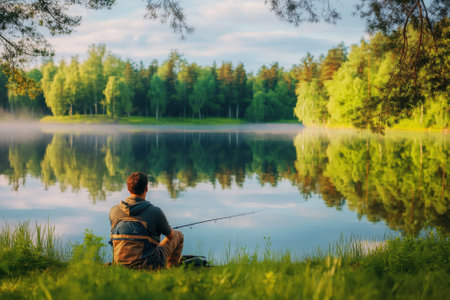Why Good Fishing Gloves Matter
For anglers, having the right pair of fishing gloves isn’t just a comfort upgrade—it’s essential gear. Whether you’re casting for bass in a local lake or battling saltwater giants offshore, good gloves can make all the difference. Grip is everything when it comes to securely handling rods, reels, and slippery fish. The best fishing gloves are designed with textured palms and fingers, letting you keep a firm hold even when things get wet and wild.
But it’s not just about grip. Hooks, sharp fins, and abrasive fishing lines put your hands at risk every time you hit the water. High-quality gloves offer protection from accidental punctures and cuts, saving you from painful injuries that could ruin your day—or your season. On top of that, many fishing spots in the U.S. see extreme weather swings. Cold weather fishing demands insulation to keep your hands nimble, while long days under the sun call for UPF-rated materials to prevent sunburn and long-term skin damage.
The right glove also helps you handle fish more effectively and humanely. A proper fit gives you full control without sacrificing dexterity, so you can unhook fish quickly and minimize stress on your catch. From tying knots to managing live bait or handling expensive gear, investing in quality fishing gloves is a smart move for any American angler who wants to fish longer, safer, and more comfortably.
Key Features to Look For
When it comes to picking the best fishing gloves for grip, protection, and cold weather comfort, American anglers know there’s more to consider than just a snug fit. The right pair of gloves will keep your hands warm, dry, nimble, and ready to reel in that trophy catch. Here’s a breakdown of the essential features you should focus on:
Material Matters
The glove material impacts everything from durability to comfort. Neoprene is a favorite among U.S. fishermen for its water resistance and insulation. Synthetic blends like polyester or nylon offer breathability and quick-drying properties, while genuine leather provides unbeatable grip but may not handle moisture as well. Choose the material based on your fishing style and local weather conditions.
Water Resistance
Wet hands are not only uncomfortable but can also lead to lost catches and even frostbite in cold climates. Look for gloves with waterproof membranes or water-repellent coatings. Some gloves feature partial finger coverage for improved dexterity while keeping your palms dry.
Insulation for Cold Weather Comfort
If you’re fishing in chilly lakes or rivers, insulation is non-negotiable. Thinsulate™ and fleece linings are popular options among American anglers because they provide warmth without adding bulk. The table below compares common insulation materials:
| Insulation Type | Warmth Level | Bulkiness | Best For |
|---|---|---|---|
| Thinsulate™ | High | Low | Winter fishing, ice fishing |
| Fleece | Medium | Medium | Crisp fall mornings, cool water outings |
| Synthetic Fiberfill | Variable | Variable | Mild to moderate cold weather |
Dexterity: Stay Nimble on the Water
A bulky glove can ruin your cast or make tying knots nearly impossible. Modern fishing gloves strike a balance between protection and finger mobility. Many brands now offer articulated fingers or partial-finger designs so you can bait hooks or handle equipment with ease—perfect for those who value both function and feel.
Touchscreen Compatibility
No one wants to strip off their gloves every time they need to check a fishing app or snap a picture of their catch. Touchscreen-compatible fingertips are a must-have feature for today’s tech-savvy anglers. Look for gloves with conductive fabric on the thumb and index finger so you can stay connected without sacrificing warmth.
By focusing on these features—material, water resistance, insulation, dexterity, and touchscreen compatibility—you’ll be better equipped to choose fishing gloves that meet the demands of American waters and weather conditions.

Top Picks for Ultimate Grip
When it comes to fishing, a reliable grip can make or break your day on the water. The best fishing gloves for grip are engineered with advanced materials like silicone-printed palms, textured synthetic leather, or rubberized coatings. These features ensure you can confidently handle slippery rods, tackle, and even live bait—regardless of whether youre battling a largemouth bass in a Midwest lake, chasing stripers off the Atlantic coast, or casting dry flies in a Rocky Mountain stream.
Secure Handling in Wet Conditions
Rain, spray, or fish slime wont slow you down with gloves designed for secure handling. Many top-rated gloves include water-resistant or quick-drying fabrics and non-slip palm patterns so you can maintain full control of your gear. This is especially important during saltwater angling, where constant wet conditions demand performance that stands up to both moisture and abrasive salt.
Real-World U.S. Use Cases
American anglers know that each style of fishing brings unique challenges. For bass fishing in states like Texas or Florida, gloves with reinforced finger pads help when flipping and pitching heavy cover. Saltwater enthusiasts along the Gulf Coast often look for gloves that combine UV protection with superior grip to manage larger gamefish and protect hands from rough lines. Fly fishermen in Montana or Colorado prefer lightweight, tactile gloves that preserve sensitivity while keeping a firm hold on delicate fly rods—even after landing trout in icy streams.
Recommended Features to Look For
Look for adjustable wrist closures for a custom fit, open-finger designs for knot tying, or touch-screen compatibility if you use digital fish finders or phones out on the boat. With these features in mind, you’ll find gloves that offer the ultimate grip without sacrificing comfort or dexterity—no matter where you cast your line across the U.S.
4. Protective Gloves for Long Days on the Water
When you’re out on the water from sunrise to sunset, the right pair of fishing gloves can make all the difference. Marathon fishing trips demand more than just basic coverage—your hands need reliable protection from sharp hooks, abrasive fish scales, harsh sunlight, and hours of repetitive motion. That’s why it’s crucial to focus on gloves that offer cut resistance, UV protection, and long-lasting comfort.
Modern fishing gloves are engineered with specialized materials to keep your hands safe and comfortable throughout extended sessions. Cut-resistant fabrics like Kevlar or synthetic blends help guard against accidental nicks from knives or gill plates, while reinforced palms add another layer of defense when handling slippery catches or bait knives. Equally important is sun protection; many top-rated gloves now feature UPF-rated fabrics that block harmful UV rays, reducing the risk of burns and long-term skin damage.
Comfort shouldn’t take a back seat during those all-day adventures. Look for moisture-wicking linings and breathable mesh panels to keep sweat at bay, plus ergonomic designs that reduce hand fatigue. Adjustable wrist closures and pre-curved fingers enhance fit and flexibility, so you can cast and reel with confidence hour after hour.
| Feature | Why It Matters | Recommended Materials/Designs |
|---|---|---|
| Cut Resistance | Prevents injuries from hooks, knives, and fish teeth/gills | Kevlar lining, reinforced synthetic palms |
| UV Protection | Shields hands from sunburn and long-term skin damage | UPF 50+ rated fabrics, full-finger coverage options |
| All-Day Comfort | Reduces sweat, chafing, and hand fatigue on marathon trips | Moisture-wicking linings, breathable mesh panels, ergonomic fit |
Selecting gloves with these key features ensures your hands stay protected—no matter how long you’re casting lines or pulling in trophy catches. For serious anglers looking to maximize performance and safety on lengthy excursions, investing in high-quality protective gloves is non-negotiable.
5. Best Gloves for Cold Weather Fishing
When it comes to fishing in chilly conditions—whether youre casting on an icy lake, wading a frigid river, or braving the winter surf along the coast—your hands need serious protection from the cold. But warmth alone isn’t enough; you still need to tie knots, feel subtle bites, and handle gear with confidence. Here’s what to look for and our top recommendations for gloves that keep your hands warm without sacrificing grip or dexterity.
Insulated Yet Responsive Materials
The best cold weather fishing gloves use high-tech insulation like Thinsulate or fleece linings that trap heat without adding too much bulk. Look for gloves with windproof and water-resistant outer shells to keep hands dry from spray, rain, and snow. Neoprene is another popular material—it insulates well and provides a snug fit, ideal for wet conditions common in winter angling.
Dexterity Matters: Fingerless and Flip-Mitt Designs
Some of the most practical gloves feature convertible designs—think fingerless gloves with fold-over mitts or thumb slits—so you can expose your fingertips for tying hooks or handling bait when needed. These hybrid styles are favorites among American anglers who refuse to let frostbite slow them down on steelhead streams or ice fishing trips.
Recommended Cold Weather Fishing Gloves
1. Simms Freestone Foldover Mitt: Combining warmth with function, these gloves offer a fleece-lined interior and water-resistant outer shell. The foldover mitt design keeps fingers nimble when you need precision.
2. Glacier Glove Ice Bay: Made with 2mm fleece-lined neoprene, these fully waterproof gloves provide excellent grip on slippery fish and tackle while keeping your hands insulated.
3. KastKing Mountain Mist: Featuring a breathable softshell exterior, anti-slip palm, and touch screen compatibility, these gloves are perfect for all-around winter fishing.
4. Fish Monkey Yeti Series: Designed for extreme cold, these gloves pair thick insulation with a pre-curved fit for natural hand movement.
Stay Warm Without Sacrificing Performance
The right pair of cold weather fishing gloves will help you stay focused on the catch instead of numb fingers. Prioritize warmth, but don’t settle for anything less than solid grip and tactile control—because even in the harshest American winters, great fishing waits for no one.
6. Care Tips and Sizing Advice
Getting the Right Fit for American Hands
When it comes to fishing gloves, a proper fit is crucial for both grip and comfort—especially during long hours on the water. American hand sizes can vary widely, so always check the brands sizing chart before you buy. Measure your palm’s circumference (just below the knuckles) and compare it to the manufacturers guide. If youre between sizes, most anglers recommend sizing up for cold weather gloves to allow room for liners or natural swelling from long use. Try on gloves with your typical fishing gear on, since jackets or base layers can impact how gloves fit at the wrist.
Sizing Hacks for Better Performance
Look for gloves with adjustable Velcro straps, stretch cuffs, or neoprene panels—these features help achieve a snug fit without restricting movement. Remember, gloves that are too tight will restrict circulation (making your hands colder), while loose gloves can reduce dexterity and grip. Don’t forget to flex your fingers and make a fist when testing new gloves; this ensures you’ll have full range of motion when casting or handling fish.
Caring for Your Fishing Gloves
A good pair of fishing gloves is an investment worth protecting. After each trip, rinse your gloves in fresh water to remove salt, dirt, and fish slime that can degrade materials over time. For synthetic or waterproof models, air dry them flat—never toss them in the dryer as high heat can warp or shrink them. For leather gloves, use a specialized cleaner and conditioner to keep the leather supple and crack-free.
Prolonging Glove Life: Quick Tips
- Avoid leaving gloves bunched up in your tackle box—this encourages mildew growth and bad odors.
- If your gloves get soaked, stuff them with newspaper overnight to draw out moisture.
- Inspect regularly for small tears or worn seams, repairing minor damage before it becomes a bigger problem.
With proper fit and regular care, your fishing gloves will deliver reliable grip, solid protection, and all-day comfort—no matter what the American outdoors throws your way.
7. Frequently Asked Questions
How durable are fishing gloves, and how long should I expect them to last?
Most high-quality fishing gloves are made to withstand tough outdoor conditions and frequent exposure to water, fish slime, and sun. Look for reinforced stitching, synthetic leathers, or strong neoprene materials for the best longevity. With regular use and proper care, a good pair can last from one to several seasons depending on frequency of fishing and the types of environments you fish in.
Are there specific gloves that work better in cold weather versus hot climates?
Absolutely. For cold weather, insulated gloves with thermal linings or windproof shells offer warmth while maintaining grip. In warm or tropical climates, opt for lightweight, breathable, and quick-drying gloves that provide UV protection but won’t overheat your hands. Fingerless designs are popular in summer while full-fingered gloves are favored for ice fishing or early spring outings.
What’s the best way to clean and maintain my fishing gloves?
Most fishing gloves can be hand-washed using mild soap and cool water. Avoid harsh detergents or machine washing unless the manufacturer specifically says it’s okay. After rinsing, let them air dry away from direct heat or sunlight to prevent material breakdown. Regular cleaning helps prevent odor buildup and extends glove life. Always check your gloves for signs of wear after each trip—patch holes or replace as needed to keep your hands protected season after season.
Any tips for storing fishing gloves during the off-season?
Store your clean, dry gloves flat or loosely rolled in a cool, dry place out of direct sunlight. Avoid compressing them under heavy gear which can damage padding or shape. If possible, keep them in a breathable bag or pouch to avoid mildew or musty smells by next season.
Is it worth investing in more than one pair of fishing gloves?
If you fish year-round or target different environments—from icy rivers to sunny saltwater flats—it’s smart to have a couple of glove options. This way, you’ll always have the right tool for the job and a backup if one pair gets wet or damaged during a long day on the water.


